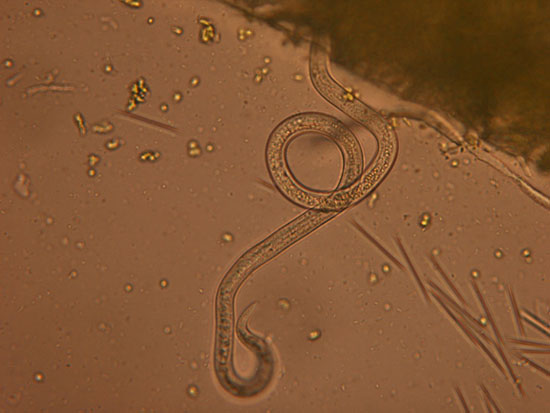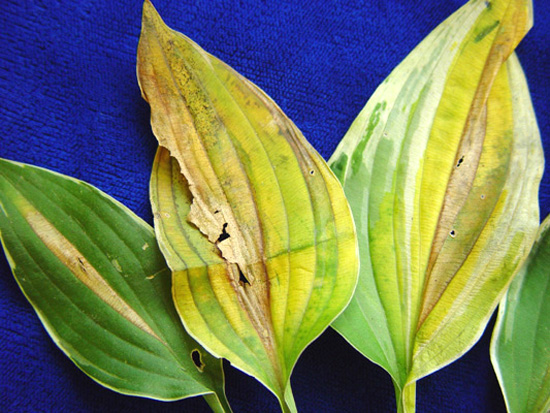Issue 12, July 16, 2010
Foliar Nematode of Hosta
We see this nematode problem at the Plant Clinic from time to time on hostas. It is probably missed, overlooked, or disregarded as due to other causes in the landscape. Especially in areas where rains have been frequent this summer, know and scout for the symptoms of foliar nematodes. Look for them on weak or struggling hosta or herbaceous perennials.
The foliar nematode is a pathogen in the genus Aphelenchoides. It lives in the plant foliage, not in the roots or soil. Nematodes are microscopic round worms. They are pathogens much like fungi or bacteria but foliar nematodes have specific needs. They require moisture to infect; they live within the plant; and they are thought to overwinter in the crown. These nematodes move in and out of the leaves when moisture is present, so they can be splashed from leaf to leaf with rain or overhead irrigation. The first image shows a foliar nematode next to the edge of a hosta leaf, as observed with a dissecting microscope at a magnification of about 40 times normal size. If you see "worms" in the soil, they are not nematodes. You will not be able to view these nematodes without a microscope.


Control of foliar nematodes is not easy. Inspect new plants for symptoms; and do not buy plants with questionable necrotic tissue. Avoid close plantings, excessively wet foliage, and overhead irrigation of symptomatic plants. Discard contaminated stock. These nematodes can survive even the cold temperatures of Minnesota, so Illinois winters are not a threat to nematode survival. Once they become established, plant removal is usually necessary. There are no chemicals that will kill the nematode and not the plant.
Foliar nematodes also appear on other herbaceous perennial hosts including anemone, creeping phlox, ground ivy, ferns, windflower, heuchera, and others. On these plants the brown areas in the foliage may take on other shapes, usually limited by veins. This nematode will not cross veins like fungal leaf pathogens or environmental scorch. Consult a plant lab if you are uncertain of the diagnosis. Do not share plants that may be infected.
A University of Illinois report on plant diseases, number 1102, Foliar Nematodes of Ornamentals, is available on-line. --Nancy Pataky
Author:
Nancy Pataky